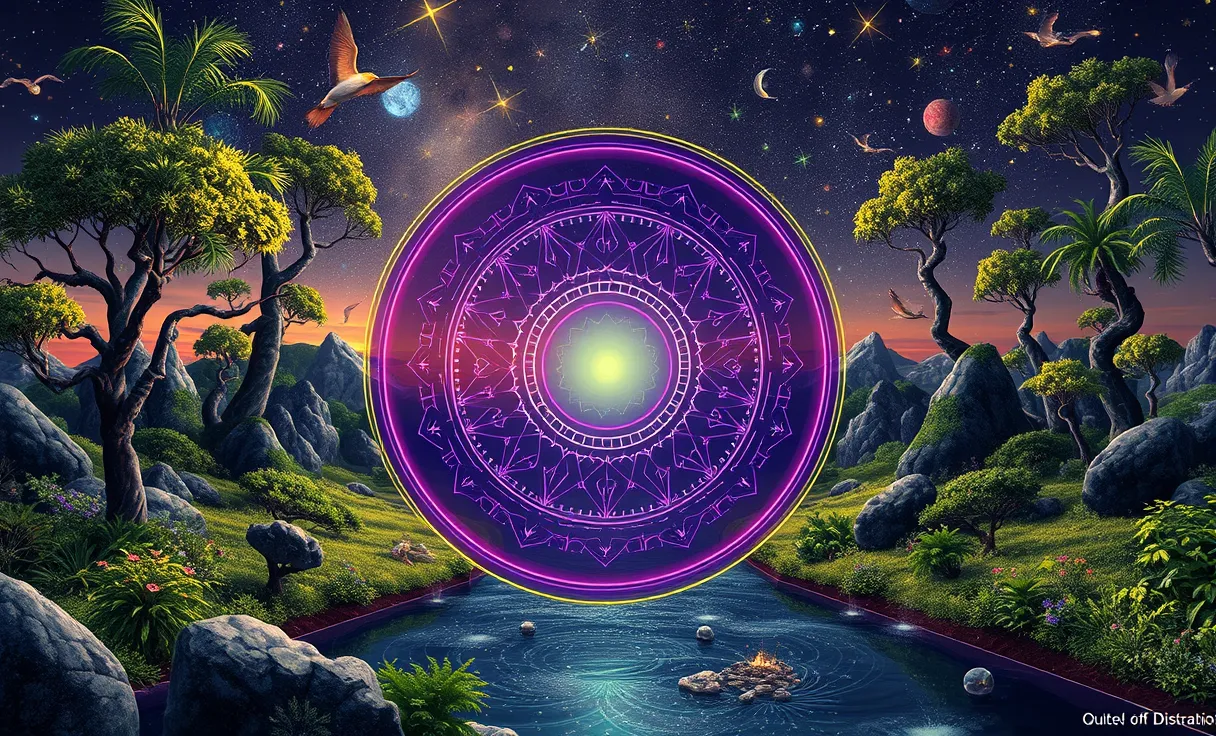
The Rise of AI-Powered Visualization Tools
Why Mental Escapes Matter Today
In our fast-paced world, stress is everywhere. Many of us are looking for ways to unwind, and guided visualizations have become increasingly popular. These exercises let your mind wander to peaceful places, reducing anxiety and enhancing focus.
AI is now stepping up to elevate this practice. Advanced algorithms can create personalized mental escapes, tailoring every detail to your preferences. Think of it as a digital coach for relaxation.
How AI Enhances Traditional Visualization Techniques
Traditional visualization exercises often follow generic scripts. AI flips this by adapting sessions to your:
- Mood and emotional state
- Favorite colors, sounds, and imagery
- Personal relaxation goals, such as reducing stress or improving creativity
By integrating user data, AI builds a fully immersive experience, making the relaxation process feel tailor-made.
The Science Behind Visualization and AI
Research proves that visualization techniques improve mental clarity, help manage stress, and even boost physical health. AI takes this a step further by blending:
- Neuro-linguistic programming (NLP) for realistic scenarios
- Real-time feedback to adjust the tone and pace of the exercise
- Advanced voice synthesis for soothing narration
This mix of technology and psychology ensures an effective, engaging escape.
Where Guided Visualization Meets Virtual Reality (VR)
If you think guided visualizations are just audio, think again. AI tools are now integrating with VR platforms, letting users “visit” serene beaches, forests, or any environment they can dream of.
With 360-degree immersive environments, users interact with their surroundings, making the experience even more realistic.
Who Benefits the Most from AI-Driven Escapes?
From busy professionals to students, everyone can find value in AI-guided visualization. It’s especially effective for:
- Burnout recovery: Quick mental breaks can rejuvenate the mind
- Chronic anxiety: Personalized content reduces overthinking
- Enhanced creativity: Fresh environments spark new ideas
As personalization deepens, even niche groups like athletes or recovering patients find tailored uses for these tools.
How AI Crafts Personalized Mental Escapes

The Role of Data in Customizing Experiences
Gathering Key User Inputs
AI-powered visualization tools start by collecting essential user data. This includes:
- Emotional states: AI identifies stress levels or mood through quick assessments.
- Preferences: Users specify favorite locations, colors, and even sounds they find calming.
- Goals: Whether relaxation, focus, or sleep improvement, the system aligns the experience with the user’s objectives.
By combining these factors, AI tailors the content to feel uniquely personal.
Adapting in Real-Time
Advanced algorithms analyze real-time user feedback, such as:
- Heart rate and breathing patterns (via wearable devices)
- Voice tone or phrasing in response to prompts
- Engagement levels tracked during the session
This real-time input allows the system to adjust narration style, pacing, or even the imagery used mid-session.
AI Technologies Powering Guided Visualization
Natural Language Processing (NLP)
NLP creates fluid, human-like narrations that adapt to user needs. It ensures:
- Clear, soothing instructions.
- Personalized phrasing based on tone preferences.
- Localization for users in different languages or regions.
This technology provides immersive, conversational guidance without sounding robotic.
Machine Learning and Personalization
Machine learning algorithms refine each session based on user interactions. Over time, the system learns:
- Which themes are most effective for relaxation.
- How long sessions should last for optimal results.
- The ideal balance between narration and silence.
Every session gets smarter and more customized, deepening the user’s experience.
The Role of Generative AI in Visuals and Sound
Crafting Personalized Visual Environments
Generative AI uses input like “tropical beach” or “snowy mountains” to create detailed, lifelike imagery. These environments feature:
- Unique lighting and textures tailored to the user’s preferences.
- Dynamic elements like moving waves or falling snow.
Users essentially get a mental escape that feels designed just for them.
Designing Relaxing Audio Scapes
Soundscapes are key to relaxation, and AI generates:
- Ambient sounds: Birds chirping, ocean waves, or crackling fire.
- Custom music tracks: AI composes melodies that match relaxation needs, like soft piano or nature-inspired harmonics.
- Binaural beats: Low-frequency tones for stress relief or focus.
These layers of sound immerse the user in a rich, calming auditory experience.
Integrating Wearable Tech for Immersive Feedback
How Wearables Enhance the Experience
Smart devices like fitness trackers and EEG headbands provide data on:
- Stress markers like elevated heart rate.
- Brainwave activity to track relaxation levels.
- Physical responses like breathing patterns or temperature changes.
AI uses this data to fine-tune sessions in real time.
Biometric-Driven Adjustments
If the user’s stress level remains high, the AI might:
- Slow down narration speed.
- Introduce deeper, rhythmic breathing exercises.
- Shift the visual scene to something more calming.
This dynamic feedback loop ensures optimal relaxation.
Collaborative Tools for Group Visualization
Guided Sessions for Teams or Groups
AI visualization tools are evolving to serve multiple users at once, great for:
- Corporate wellness programs.
- Group therapy sessions.
- Online relaxation communities.
Participants can explore shared virtual environments or enjoy synchronized narration.
Synchronizing Experiences Across Devices
Advanced systems synchronize VR headsets, mobile apps, and desktop platforms, ensuring everyone experiences the same journey. This feature fosters connection and collaboration.
Tools and Devices Enhancing AI-Guided Visualization
Must-Have Tools for AI-Powered Visualization
Mobile Apps for On-the-Go Relaxation
AI-guided visualization apps bring stress relief straight to your pocket. Popular apps often feature:
- Personalized sessions: Tailored to your mood, preferences, and daily goals.
- Easy interfaces: Simple navigation makes it effortless to use anytime.
- Offline access: Downloadable content for guided relaxation without an internet connection.
Some of the top contenders in this space include apps like Calm, Insight Timer, and emerging AI-powered platforms.
VR Headsets for Immersive Experiences
Virtual reality devices like the Meta Quest 3, Sony PlayStation VR2, and HTC Vive offer unparalleled immersion. With these tools, users can:
- Fully explore 360-degree virtual environments, from tranquil beaches to serene forests.
- Interact with their surroundings, adding a sense of realism.
- Customize their settings for length, tone, and engagement level.
Pairing VR with AI enhances guided visualization by providing fully engaging escapes.
Smart Displays for Guided Group Sessions
Devices like the Amazon Echo Show or Google Nest Hub make guided visualization a shared experience. Key features include:
- Visual and audio guidance on large, easy-to-see screens.
- Group relaxation sessions for families or workplaces.
- Integration with smart home devices for ambient lighting and sound.
These tools are excellent for collaborative mindfulness in both homes and offices.
Wearables That Elevate Visualization
Smartwatches and Fitness Trackers
Devices like Apple Watch, Fitbit, or Garmin offer seamless integration with guided visualization apps. These gadgets:
- Track stress markers like heart rate and skin temperature.
- Provide real-time feedback on the user’s relaxation progress.
- Suggest when it’s time for a mental escape based on activity or stress levels.
Wearables bring a level of personalization that makes each session more effective.
EEG Headbands for Neurofeedback
Cutting-edge headsets like Muse 2 or Flow Neuroscience track brainwave activity to refine guided visualizations. These devices:
- Detect alpha, beta, and theta brainwaves, adjusting content to encourage relaxation.
- Offer post-session insights to help users understand their mental state.
- Improve focus and mindfulness through biofeedback.
By syncing brain activity with visualization tools, users achieve deeper, targeted relaxation.
Devices for Audio and Soundscapes
Noise-Canceling Headphones
High-quality headphones from brands like Bose, Sony, or AirPods Pro are essential for auditory immersion. They:
- Block out distractions for a more focused experience.
- Deliver crisp, clear soundscapes or binaural beats.
- Allow users to adjust volume and tones for maximum comfort.
Clear audio helps reinforce the sense of being in a completely different environment.
Smart Speakers for Surround Sound
Speakers like Sonos One or Echo Studio create an enveloping soundscape for guided visualization sessions. Key benefits include:
- Multi-directional sound that feels immersive.
- Integration with AI-guided apps to play personalized content.
- Hands-free controls via voice assistants like Alexa or Google Assistant.
These speakers turn a simple living room into a virtual oasis.
Advanced Tools for Power Users
Haptic Feedback Wearables
Devices like Teslasuit Gloves or bHaptics TactSuit bring tactile sensations into the virtual experience. Users can:
- Feel textures, like the softness of grass or the warmth of sunlight.
- Enhance physical engagement with their virtual environment.
- Connect body and mind more effectively for guided meditation.
Haptic technology ensures users feel fully immersed in their mental escapes.
AR Glasses for Augmented Reality Visualizations
AR glasses, such as Nreal Air or Magic Leap, add a new dimension to AI visualizations. Users can:
- Superimpose calming scenes over their actual environment.
- Blend relaxation with real-world interactions for stress management in public spaces.
- Use guided exercises discreetly, enhancing mindfulness without needing a private space.
This blend of reality and imagination creates flexibility for users in any setting.
Combining Tools for Seamless Relaxation
Smart Ecosystems for Personalized Escapes
Integrating multiple devices creates a cohesive, multi-sensory experience. Imagine a setup where:
- A wearable tracks your stress and cues your VR headset to start a relaxation session.
- Smart speakers sync ambient sounds with visual scenes.
- Lighting systems dim or adjust colors based on the virtual environment.
Platforms like Google Home or Apple HomeKit streamline these connections for effortless guided visualization.
Portable Kits for Busy Professionals
For people on the go, a compact setup might include:
- A high-resolution smartphone.
- Lightweight noise-canceling earbuds.
- A wearable like a smartwatch for biometric feedback.
This simple yet powerful combination allows relaxation anytime, anywhere.
Conclusion: AI-guided visualization tools and devices offer endless possibilities for creating serene, immersive escapes. As technology evolves, so does the ability to personalize these experiences for every user.
Future Innovations in AI-Guided Visualization

Pushing the Boundaries of Immersion
Hyper-Realistic Environments with AI
As generative AI advances, expect even more vivid, lifelike virtual worlds. Innovations could include:
- Dynamic weather patterns that adapt in real time, like sunsets that fade naturally or clouds that drift overhead.
- Interactive elements: Users could touch objects, hear realistic sounds, or even “walk” through their virtual escapes.
- Haptic feedback: Wearable devices may simulate physical sensations like soft sand underfoot or a cool breeze.
This level of realism could completely blur the line between virtual and actual experiences.
Multi-Sensory AI Integration
Future tools may incorporate senses beyond sight and sound. Researchers are exploring:
- Scent emitters that release calming fragrances like lavender.
- Taste simulators for subtle sensations, such as sipping warm tea by a digital fire.
- Temperature-controlled environments that align with the virtual scene, like cool air for a mountain retreat.
Combining these sensory inputs will create a deeper, all-encompassing experience.
Real-World Applications of AI Visualization
Therapeutic Uses in Healthcare
AI-guided visualization is already being tested in medical fields, but the potential is enormous for:
- Pain management: Patients use customized visual escapes to reduce discomfort during treatment.
- Mental health therapy: AI provides supportive tools for managing anxiety, PTSD, or depression.
- Sleep improvement: Personalized bedtime journeys promote relaxation for better rest.
With clinical validation, these tools could become a staple in modern healthcare.
Education and Training Benefits
Beyond relaxation, guided visualizations could revolutionize learning:
- Creative brainstorming: Artists and writers use AI-guided scenes for inspiration.
- Skill development: Athletes mentally rehearse movements in detailed environments.
- Immersive learning: Students “travel” to ancient Rome or explore the cosmos during lessons.
By engaging the mind more fully, these tools make abstract concepts come alive.
Societal Impacts of Personalized Escapes
Bridging Accessibility Gaps
AI ensures guided visualizations are available to everyone, regardless of physical or financial limitations. This could help:
- Individuals with limited mobility explore far-off places.
- Low-income users access affordable mental health support.
- Diverse communities experience content tailored to their cultures and preferences.
As costs drop, these tools may become a universal resource for relaxation and growth.
Ethical Concerns and Balancing Technology
However, there are potential downsides to consider:
- Over-reliance: Could frequent use of virtual escapes lead to withdrawal from real-world interactions?
- Data privacy: Protecting sensitive personal data, such as emotional states and biometric feedback, will be crucial.
- Bias in design: AI must be inclusive to avoid marginalizing certain groups or preferences.
Careful regulation and ethical development will be key to maximizing benefits.
The Future of AI-Guided Wellness
Blending with AI Companions
Future systems might pair guided visualizations with AI companions. These digital assistants could:
- Offer personalized coaching during sessions.
- Act as calming presences, responding to user queries or emotions.
- Evolve with the user, improving over time based on feedback and preferences.
This synergy could redefine how we view mental health and wellness.
Expanding Beyond Relaxation
Visualization tools may also find roles in:
- Productivity boosts: Quick sessions designed to refocus and energize users.
- Virtual tourism: Affordable, eco-friendly alternatives to physical travel.
- Spiritual exploration: AI-guided meditations for deeper self-reflection.
These diverse applications highlight the limitless potential of this technology.
Conclusion: A World of Personalized Serenity Awaits
AI-guided visualization is not just a trend—it’s a revolution in mental wellness, creativity, and personal growth. With continued innovation, these tools promise to reshape how we relax, learn, and explore, making tranquility accessible to all.
Resources for Exploring AI-Guided Visualization
Recommended Apps and Platforms
Popular Apps for Guided Visualization
Start your journey with these top-rated apps designed to relax and inspire:
- Calm: Offers guided meditations, sleep stories, and visual journeys tailored to stress relief and better sleep.
Visit Calm - Headspace: Combines mindfulness exercises with imaginative visualizations, perfect for beginners and experts alike.
Visit Headspace - Insight Timer: Features a vast library of free meditations, including AI-assisted visual escapes.
Visit Insight Timer - Revery: Uses AI to guide users through personalized mental health and focus exercises.
Learn More About Revery
Platforms Integrating VR and AI
For a more immersive experience, try:
- TRIPP: A VR app offering fully customizable meditative journeys, available on major headsets like Oculus and Vive.
Explore TRIPP - Healium: Combines VR, AR, and AI to create visual escapes designed to reduce anxiety and boost focus.
Learn More About Healium - Nature Treks VR: Allows users to explore breathtaking AI-generated environments, from serene forests to underwater worlds.
Check Out Nature Treks VR
Books and Research on Visualization
Must-Read Books on Mental Escapes
- “Creative Visualization” by Shakti Gawain
A classic guide to harnessing the power of visualization for personal growth and relaxation.
Find on Amazon - “The Relaxation Response” by Herbert Benson, MD
Explores the science behind stress reduction techniques like guided imagery.
Find on Amazon - “The Healing Power of the Mind” by Joan Borysenko, PhD
Offers insights into how visualization and mindfulness aid healing and stress management.
Find on Amazon
Academic Research
- “The Neural Mechanisms of Guided Imagery and Meditation”
This study explores how visualization affects brainwave activity.
Read on PubMed - “Virtual Reality for Mental Health” by Riva et al.
Highlights the role of VR in stress reduction and mindfulness practices.
Access Full Text
Online Courses and Tutorials
Learn Visualization Techniques
- Udemy: Guided Meditation and Visualization for Beginners
Covers foundational visualization techniques, including mindfulness exercises.
Visit Course - Coursera: Science of Well-Being (Yale University)
A free course that integrates relaxation techniques with psychological insights.
Enroll Here
Mastering AI Visualization Tools
- LinkedIn Learning: Introduction to AI in Wellness
Teaches how AI enhances meditation and mental health apps.
Explore Course - FutureLearn: Virtual Reality and Mindfulness
Explores the intersection of VR, AI, and mental health.
Sign Up
Communities and Forums
Engage with Like-Minded Users
- Reddit: Subreddits like r/Meditation and r/VRGaming discuss guided visualizations and VR integration.
- Insight Timer Community: Join forums to connect with fellow users and instructors.
Professional Networks
- Mindfulness Professionals Group (LinkedIn): A space for practitioners exploring technology in mental wellness.
- VR and AI in Healthcare (Slack): Connect with developers and mental health professionals using AI-guided visualizations.
Additional Hardware Resources
Where to Find Devices
- VR Headsets: Available on Best Buy, Oculus Store, and Amazon.
- Wearables: Smartwatches and EEG headbands are widely available through Apple, Fitbit, and Muse.
Tech Support and Tutorials
Visit device-specific websites like Oculus Support or Muse Help Center for step-by-step guides.